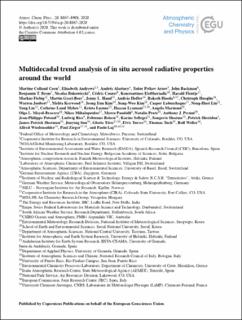| dc.contributor.author | Coen, Martine Collaud | |
| dc.contributor.author | Andrews, Elisabeth | |
| dc.contributor.author | Alastuey, Andrés | |
| dc.contributor.author | Arsov, Todor Petkov | |
| dc.contributor.author | Backman, John | |
| dc.contributor.author | Brem, Benjamin T. | |
| dc.contributor.author | Bukowiecki, Nicolas | |
| dc.contributor.author | Couret, Cedric | |
| dc.contributor.author | Eleftheriadis, Konstantinos | |
| dc.contributor.author | Flentje, Harald | |
| dc.contributor.author | Fiebig, Markus | |
| dc.contributor.author | Gysel-Beer, Martin | |
| dc.contributor.author | Hand, Jenny | |
| dc.contributor.author | Hoffer, András | |
| dc.contributor.author | Hooda, Rakesh | |
| dc.contributor.author | Hueglin, Christoph | |
| dc.contributor.author | Joubert, Warren | |
| dc.contributor.author | Keywood, Melita | |
| dc.contributor.author | Kim, Jeong Eun | |
| dc.contributor.author | Kim, Sang-Woo | |
| dc.contributor.author | Labuschagne, Casper | |
| dc.contributor.author | Lin, Neng-Huei | |
| dc.contributor.author | Lin, Yong | |
| dc.contributor.author | Myhre, Cathrine Lund | |
| dc.contributor.author | Luoma, Krista | |
| dc.contributor.author | Lyamani, Hassan | |
| dc.contributor.author | Marinoni, Angela | |
| dc.contributor.author | Mayol-Bracero, Olga L. | |
| dc.contributor.author | Mihalopoulos, Nikos | |
| dc.contributor.author | Pandolfi, Marco | |
| dc.contributor.author | Prats, Natalia | |
| dc.contributor.author | Prenni, Anthony J. | |
| dc.contributor.author | Putaud, Jean-Philippe | |
| dc.contributor.author | Ries, Ludwig | |
| dc.contributor.author | Reisen, Fabienne | |
| dc.contributor.author | Sellegri, Karine | |
| dc.contributor.author | Sharma, Sangeeta | |
| dc.contributor.author | Sheridan, Patrick | |
| dc.contributor.author | Sherman, James Patrick | |
| dc.contributor.author | Sun, Junying | |
| dc.contributor.author | Titos, Gloria | |
| dc.contributor.author | Torres, Elvis | |
| dc.contributor.author | Tuch, Thomas | |
| dc.contributor.author | Weller, Rolf | |
| dc.contributor.author | Wiedensohler, Alfred | |
| dc.contributor.author | Zieger, Paul | |
| dc.contributor.author | Laj, Paolo | |
| dc.date.accessioned | 2020-08-06T07:43:49Z | |
| dc.date.available | 2020-08-06T07:43:49Z | |
| dc.date.created | 2020-08-05T10:31:29Z | |
| dc.date.issued | 2020 | |
| dc.identifier.citation | Atmospheric Chemistry and Physics. 2020, 20, 8867-8902. | en_US |
| dc.identifier.issn | 1680-7316 | |
| dc.identifier.uri | https://hdl.handle.net/11250/2671017 | |
| dc.description.abstract | In order to assess the evolution of aerosol parameters affecting climate change, a long-term trend analysis of aerosol optical properties was performed on time series from 52 stations situated across five continents. The time series of measured scattering, backscattering and absorption coefficients as well as the derived single scattering albedo, backscattering fraction, scattering and absorption Ångström exponents covered at least 10 years and up to 40 years for some stations. The non-parametric seasonal Mann–Kendall (MK) statistical test associated with several pre-whitening methods and with Sen's slope was used as the main trend analysis method. Comparisons with general least mean square associated with autoregressive bootstrap (GLS/ARB) and with standard least mean square analysis (LMS) enabled confirmation of the detected MK statistically significant trends and the assessment of advantages and limitations of each method. Currently, scattering and backscattering coefficient trends are mostly decreasing in Europe and North America and are not statistically significant in Asia, while polar stations exhibit a mix of increasing and decreasing trends. A few increasing trends are also found at some stations in North America and Australia. Absorption coefficient time series also exhibit primarily decreasing trends. For single scattering albedo, 52 % of the sites exhibit statistically significant positive trends, mostly in Asia, eastern/northern Europe and the Arctic, 22 % of sites exhibit statistically significant negative trends, mostly in central Europe and central North America, while the remaining 26 % of sites have trends which are not statistically significant. In addition to evaluating trends for the overall time series, the evolution of the trends in sequential 10-year segments was also analyzed. For scattering and backscattering, statistically significant increasing 10-year trends are primarily found for earlier periods (10-year trends ending in 2010–2015) for polar stations and Mauna Loa. For most of the stations, the present-day statistically significant decreasing 10-year trends of the single scattering albedo were preceded by not statistically significant and statistically significant increasing 10-year trends. The effect of air pollution abatement policies in continental North America is very obvious in the 10-year trends of the scattering coefficient – there is a shift to statistically significant negative trends in 2009–2012 for all stations in the eastern and central USA. This long-term trend analysis of aerosol radiative properties with a broad spatial coverage provides insight into potential aerosol effects on climate changes. | en_US |
| dc.language.iso | eng | en_US |
| dc.rights | Navngivelse 4.0 Internasjonal | * |
| dc.rights.uri | http://creativecommons.org/licenses/by/4.0/deed.no | * |
| dc.title | Multidecadal trend analysis of in situ aerosol radiative properties around the world | en_US |
| dc.type | Peer reviewed | en_US |
| dc.type | Journal article | en_US |
| dc.description.version | publishedVersion | en_US |
| dc.rights.holder | © Author(s) 2020. | en_US |
| dc.source.pagenumber | 8867-8902 | en_US |
| dc.source.volume | 20 | en_US |
| dc.source.journal | Atmospheric Chemistry and Physics | en_US |
| dc.identifier.doi | 10.5194/acp-20-8867-2020 | |
| dc.identifier.cristin | 1821718 | |
| dc.relation.project | EC/H2020/654109 | en_US |
| dc.relation.project | EC/H2020/739530 | en_US |
| dc.relation.project | NILU: 115045 | en_US |
| dc.relation.project | NILU: 117001 | en_US |
| dc.relation.project | NILU: 113007 | en_US |
| dc.relation.project | NILU: 7726 | en_US |
| cristin.ispublished | true | |
| cristin.fulltext | original | |
| cristin.qualitycode | 2 | |

